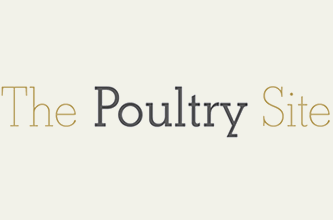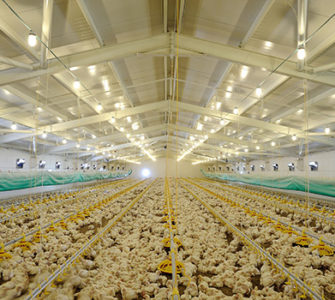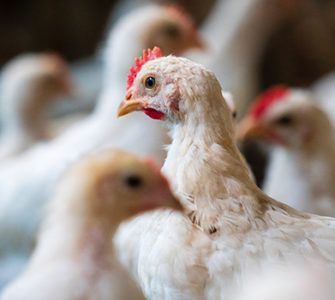Researchers find potential link between feeding DDGS and necrotic enteritis in broilers
06 August 2014
High levels of DDGS (15 per cent) were found in studies at Auburn University to amplify mild to moderate cases of necrotic enteritis into more severe cases. Even with a mild case of necrotic enteritis, broiler performance was more adversely affected in birds fed DDGS than those that were not.
The US Poultry and Egg Association (USPOULTRY) and the USPOULTRY Foundation announced the completion of a funded research project at Auburn University, Auburn, Alabama, that found a potential link between feeding distillers dried grains with solubles (DDGS) and necrotic enteritis in broilers.
The project is part of the association’s comprehensive research programme encompassing all phases of poultry and egg production and processing.
Necrotic enteritis, caused by Clostridium perfringens, is an important health issue for the broiler industry. The diminishing use of antibiotics makes controlling necrotic enteritis even more difficult.
Researchers at Auburn University, led by Dr Kenneth Macklin, studied the impact of feeding DDGS on the incidence and severity of necrotic enteritis in broilers.
Feeding a high inclusion level (15 per cent) of DDGS in the presence of a mild to moderate C. perfringens challenge can lead to more severe cases of necrotic enteritis and can negatively impact adjusted feed conversion ratios. This research indicates that the DDGS inclusion rate should be considered in a programme to control necrotic enteritis.
In their full report, Kenneth S. Macklin and William A. Dozier III say that necrotic enteritis is a serious issue for the poultry industry. In the near future, it may become even more of a problem with reduced use of antibiotics/anticoccidials in poultry feed.
The use of DDGS in poultry diets has increased as the availability of this reasonably priced feed ingredient has risen over the past several years. Preliminary research conducted in our laboratories had implied that feeding DDGS might lead to an increase in necrotic enteritis development.
The objective of this study was to determine the role, if any, of DDGS in necrotic enteritis development. To accomplish this, two experiments were performed. In the first experiment birds were fed a standard corn soy diet that had either 7.5 or 15 per cent DDGS included in the diet.
Birds were then challenged, first with a coccidia cocktail and then four days later, with C. perfringens over three consecutive days. Ten days after the coccidia cocktail was administered, the birds were necropsied. During the necropsy, necrotic enteritis and coccidiosis lesions were scored, and samples were collected for C. perfringens recovery. In addition, feed conversion, body weight and mortality data were collected.
Using the results from the first study, a second experiment was performed using the most detrimental level of DDGS (15 per cent) and three different challenge levels (low, medium and high) of C. perfringens.
The goal of this experiment was to determine if DDGS influenced the severity or incidence of necrotic enteritis development with these three different levels of C. perfringens. The same experimental measurements were collected in this experiment as in the first.
The first experiment did not clearly define the relationship between feeding DDGS and necrotic enteritis development. What was obvious, though, was that the treatment group fed the 15 per cent DDGS diet had a significantly worse 15- to 28-days adjusted feed conversion ratio (AFCR) than the group fed the diet that did not contain DDGS.
Though not significant, the group fed the intermediate DDGS diet (7.5 per cent) had six points higher AFCR than the group fed the control diet. This is important because the 15- to 28-day period is when the birds were challenged with coccidia and C. perfringens.
Based on these as well as previous results from our labs, Macklin and Dozier concluded that 15 per cent DDGS was more likely to have an effect on necrotic enteritis development.
In the second experiment, similar differences were seen in the 15- to 28-days AFCR, with the groups fed the 15 per cent DDGS diet having higher AFCR values than similarly challenged birds fed a diet containing no DDGS.
Not surprisingly, the birds fed either diet (0 or 15 per cent DDGS) that were not challenged had similar AFCR.
Also in that experiment, birds that were fed the 15 per cent DDGS diet and challenged with the low and medium dose of C. perfringens had more severe necrotic enteritis lesions then those that were not fed a diet with DDGS. Both groups given the high challenge doses had a similar number of cases of severe necrotic enteritis lesions.
These results show that high levels of DDGS may lead to decreased bird performance. When the birds have a mild to moderate C. perfringens challenge, this can lead to more severe cases of necrotic enteritis as well as a decrease in bird live performance.
DDGS is commonly being used by the poultry industry. In this report it is demonstrated that high levels of DDGS (15 per cent) can amplify mild to moderate cases of necrotic enteritis into more severe cases. It also shows that even with a mild case of necrotic enteritis, bird live performance is more negatively impacted in those birds fed DDGS versus those that were not.
Article courtesy of ThePoultrySite.com
Posted on September 9, 2014

















